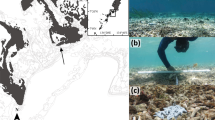Abstract
THE tubiculous Maldanid polychætes are among the most abundant infaunal components of intertidal and sub-tidal bottom communities of the North American Atlantic coast. Within their respective ranges the two species Clymenella torquata Leidy and Axiothella mucosa Andrews show a striking dichromatism: populations may be either green or orange. A population inhabiting a particular microgeographic area is always consistent, although the distance over which a colour change occurs may be only a few miles. Continuous intergraduations do not occur. A third closely related species, Euclymene collaris Claparède, does not undergo the colour change; it exists only in the orange form even where it is sympatric with the green forms of the first two. Table 1 lists the colour of populations found at each of seven macrogeographical locations sampled by me.
Similar content being viewed by others
References
Lemberg, R., and Legge, J. W., Hematin Compounds and Bile Pigments (New York, 1949).
Okay, S., Nature, 155, 635 (1945).
Dales, R. P., Nature, 190, 168 (1961).
O'Eochla, C., in Comparative Biochemistry of Photoreactive Systems, edit. by Allen, M. B. (Academic Press, New York, 1960).
Author information
Authors and Affiliations
Rights and permissions
About this article
Cite this article
MANGUM, C. Source of Dichromatism in Two Maldanid Polychætes. Nature 195, 198–199 (1962). https://doi.org/10.1038/195198b0
Issue Date:
DOI: https://doi.org/10.1038/195198b0
- Springer Nature Limited





